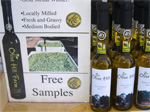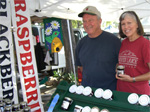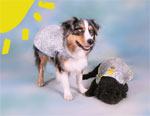HEALTH CONSCIOUS BUYING FARMERS MARKETS IN AMERICA
by Bonnie Carroll During the past five months, with gas costs soaring, as well as food costs, many professionals are recommending tha t everyone shop for fresh food and prepare meals at home. Buying fast foods and quick frozen dishes is very expensive and a mute point in the journey for good health through good eating. t everyone shop for fresh food and prepare meals at home. Buying fast foods and quick frozen dishes is very expensive and a mute point in the journey for good health through good eating. I love Farmers Markets and visit them wherever I go. Recently, in San Leo, Italy I was amazed at the fine quality and rich colors of the farm tomatoes, and in Ojai, Calfiornia they have incredibly beautiful eggplants and berries in their  Sunday morning market. My own city has Farmers Markets weekly in five different locations, and today they not only sell the finest fresh produce, chicken, eggs, fish, and flowering plants, but they have also added some accoutrement products for shoppers convenience. Sunday morning market. My own city has Farmers Markets weekly in five different locations, and today they not only sell the finest fresh produce, chicken, eggs, fish, and flowering plants, but they have also added some accoutrement products for shoppers convenience. The Buttonwood Farm has some outstanding wines that are availa ble in popular restaurants, but also are now available to market shoppers who can pair wines with the dishes they are preparing for dinner with their organic fruits and vegetables. Another great product is Olive Hill, with a variety of wonderful oils to enhance fruits & vegetables, meats, fish and just great for bread dipping with a glass of red wine. Fresh raspberry and ble in popular restaurants, but also are now available to market shoppers who can pair wines with the dishes they are preparing for dinner with their organic fruits and vegetables. Another great product is Olive Hill, with a variety of wonderful oils to enhance fruits & vegetables, meats, fish and just great for bread dipping with a glass of red wine. Fresh raspberry and  strawberry preserve lovers will be pleased to find home made jams, jellies and preserves to enjoy with fresh toast or as a side for fresh fruit desserts. strawberry preserve lovers will be pleased to find home made jams, jellies and preserves to enjoy with fresh toast or as a side for fresh fruit desserts. The simple truth is that buying fresh foods and preparing them at home may take a few minutes longer, but in the long run you save money, enjoy delicious seasonal produce, and keep your loved ones immune system at optimum levels. Information can be found on most city websites for dates, times and locations of Farmer’s Markets, so look them up and have a fun experience at your local lmarket. Mangia Bene!
PILLOW TALK
Introducing Parker & Morgan, Los Angeles, a new retail concept devoted to sleeping well Parker & Morgan will debut a new sleep and wellness retail concept in the US tomorrow with the opening of its Canoga Park store, based on the premise that life is better with a good night’s sleep. The new store is distinguished by the largest selection of sleep-related products under one roof; including 140 different pillows, and a highly trained staff who can recommend the right sleep tools for each customer - from pillow choices based on sleep positions to soothing aromatherapy and enlightened wellness products. “At Parker & Morgan, we look at the world in thirds: one-third work, one-third play and one-third sleep. We believe our lives will be better if we sleep better,” says Paul Backlund, Parker & Morgan U.S. marketing director. “We have designed our products to enable everyone to sleep well. A good sleep in a busy urban life is crucial to being well-energized and happy." Choosing the perfect pillow for individual needs has been a daunting task up until now. Each sleep consultant in the retail stores are trained and knowledgeable about the benefits of sleeping correctly, and are able to help the customer select the right pillows for their sleeping needs, be it at home, office or while traveling. Customers can choose from feather, down, micro fiber, herbal, memory foam, latex and sustainable materials. In addition to traditional bed pillows, Parker & Morgan design travel, office, pregnancy, aromatherapy, children’s and decorative pillows and a full range of treatment pillows for insomnia, aches and pains, allergies and restless leg syndrome. In addition to pillows and an extensive range of proprietary sleep related products, Parker & Morgan will offer special monthly sleep workshops with advice from chiropractors, allergists, homeopaths, herbalists and those experienced in aromatherapy and spa treatments. Featured both on www.parkerandmorgan.com and in each retail store, these workshops are focused on educating people to enhance wellness.
The inviting Parker & Morgan stores introduce a luxe contemporary style utilizing a neutral color palate of rich natural materials including limed and teak woods, terrazzo stone and marble, glass, leather, textiles, and metals. Parker & Morgan have created a soothing, ordered environment that showcase the store’s products and encourage a tactile sense of discovery. Rotating seasonal and themed displays of products add color and a fashion element to the stores.
www.parkerandmorgan.com
PET HEALTH CANINE HYPERMIA:
Protection from Learning the Hard Way  Heat kills dogs. We all know it, and most of us do the best we can to help our dogs stay comfortable and survive the heat as it exists wherever we are. Whether you live in the Sonoran desert of Arizona or the mountains of Alaska, dogs are affected by rising temperatures of the summer seasons. With global warming driving average temperatures upwards, the situation is not going to be any easier for our furry, slobbering best friends. Heat kills dogs. We all know it, and most of us do the best we can to help our dogs stay comfortable and survive the heat as it exists wherever we are. Whether you live in the Sonoran desert of Arizona or the mountains of Alaska, dogs are affected by rising temperatures of the summer seasons. With global warming driving average temperatures upwards, the situation is not going to be any easier for our furry, slobbering best friends.
In the process of developing, testing, patenting, and marketing the Chillybuddy Dog Cooling Jacket we have learned many lessons about the physiology of dogs, environmental physics, and most importantly, the lack of understanding most dog owners have about how their canine companions work. To a terrifying degree, people tend to believe notions that if simply taken at the surface, defy any basic understanding of how our world works and certainly any understanding about dogs. In an odd twist, we have noticed that awareness and knowledge of canine heat issues seems to be inversely related to the average temperature of a region. We have found that Canadians are generally very knowledgeable and concerned about the thermal welfare of their dogs, while in some ways the dog owners of the Southern United States are a bit more … let’s say, casual … in their knowledge. In some ways, with heat, it’s the old story of familiarity breeding contempt. So let’s start with some basic facts about dogs and heat: - Dogs have defective cooling systems. They can lose heat only through respiration and the physical mechanisms that provide that function: nasal structure, lungs, mouth, or through their paws. Like any heat producing engine, they can also radiate heat to the environment. This is a great system for an animal that evolved for life in the taiga and the ice age, or the cold deserts at night. Not so good for a sled dog in Florida.
- The equivalent of 1250 Calories/square meter/hr of infrared energy strike the Earth at sea level – much more at higher elevations. This is approximately the energy requirement for a reasonably active 50 pound dog per day.
- Normal temperature for a dog is in the range of 101-102 degrees Fahrenheit.
- Dogs are considered hyperthermic when their body temperature exceed 106F (The Journal of Veterinary Internal Medicine 2006;20:38-46).
- The mortality rate for hyperthermic dogs treated immediately by qualified clinicians is 50%, due to irreversible changes in blood chemistry (JVIM, Ibid).
In summary: it’s hot out there folks, dogs are already hot, and there isn’t a whole lot of room (4-5 degrees F) between doing-fine and likely-to-die. The input of the sun is important because, in dogs, we are dealing with a system that is already overloaded by eliminating the normal heat from burning their intake of food for energy. In a walk lasting an hour, the average dog is exposed to almost as much energy as they consume through food in a day. Even if they absorb only 10% of that solar influx, they are adding significantly to their thermal load. If the average fit 50 pound dog burns about 1400 Calories per day, that translates into an average of 56 Calories of energy burn an hour. If the dog is out for a leisurely walk, that rate goes up, so let’s say there’s 100 Calories of energy to be eliminated. Given that a dog doesn’t occupy anything like a square meter, let’s say he is exposed to a third of that total influx or about 400 Calories per hour. Assuming the same 10% absorption -- based on coat temperature measurements it can be inferred that this is probably a low number – the dog will absorb about 40 Calories on that walk. That absorption is an additional 40% load on an already challenged heat elimination system. Now let’s move to the basic myths: - My dog’s long coat protects him from the heat. This myth has to be number one, and it comes in a corollary version: my dog is double coated so isn’t bothered by heat. If such a simple mechanism can reposition something from one set of thermodynamic laws to an-as-yet undiscovered set, then we really ought to let NASA know about this. A fur coat is an insulator; two fur coats is a better insulator. Yes, it’s true that longer hair helps to reduce the transmission of heat absorbed at the tip of the coat to the skin. However, the longer coat also creates a layer of air that insulates the dog. In this case, however, that air is heated by two sources: the dog and the outside environment. In the event that insulating air mass exceeds the skin temperature of the dog, the heat transference will be reversed and flow to the skin.
- My dog’s short coat protects him from the heat. The short coat does help the dog radiate its own heat to the environment more than a longer coat – we all see that in the cold months. But the short coated dog is that much more likely to absorb heat from the solar influx, and a black short coated dog is the most at risk. See next point.
- My dog is tough. Very popular among owners of Dobermans, Rottweilers, various American Bulldog breeds, etc. A toughminded dog has the same metabolism as any other canine, but is less likely to let you know it is suffering until it cannot carry on. From there on see point 5 under facts. Add to that the fact that many of these “tough dogs” are black and short coated, and you have a major problem.
- I walk my dog at night. Good, that’s a start. But if it’s 105F in Las Vegas at 9 in the evening, you and the dog are still being bombarded by radiant energy. Your eyeballs say it is dark, but the heat around says the world is glowing with radiant thermal energy. If it’s hot, it’s hot.
What can a pet owner do about this problem? Plenty, and you probably already know all of this, but here it is just as a reminder: - WATER, WATER, WATER. The dog should always have available plenty of fresh cool water. If the owner is going for an hour long walk, there are some very nice new devices for carrying water and providing it to the dog.
- Don’t overwork your dog. The fact that the dog is nuts whenever it sees a tennis ball does not mean that it’s a good idea to throw the ball for 30 minutes when it’s 95F outside. Even though items like the Chillybuddy will provide a wider range of comfort for the dog in the heat, we are still dealing with a cooling system that is inherently challenged. If you’re going to work a dog like that, take a good clue from the best agility and Search dog handlers, and be ready with lots and lots of water, a good cooling jacket that actually works, and perhaps a cool pond in which to quickly dissipate heat.
- Provide shade whenever possible. Buddy’s unwillingness to come out of the shade to walk was what gave me a clue to develop our product. Shade represents reduced heat influx (though not entirely) and thus reduces the additional strain on the dog’s system.
- Air movement is good, more is better. A breezy, shady spot on a warm day helps a dog even though they don’t perspire. Dogs can lose heat through radiation, helping unload some work from the primary cooling systems.
- Provide a dip in a pool or stream. Water on the body provides a means for evaporative cooling. However, that cooling mechanism works well only if the airflow is plentiful and the heat being absorbed by evaporation is from the dog, not the environment. One of the problems with the older style towel wraps and chamois is that they turn into a sauna underneath because they emphasize water to the exclusion of air. Evaporative cooling is about 80% airflow, 20% water. The Chillybuddy Dog Cooling Jacket provides that evaporative cooling for the dog.
- Watch for the slightest signs of heat stress. Given that some excellent dog handlers and vets have all had their dogs overheat and collapse, I am almost not inclined to even list these. I think that too often the average pet owner automatically watches for these. Unless they see these signs, they think everything is fine with the dog. In our analysis, a dog unprotected from additional heat uptake and not provided some means of evaporative cooling is headed towards a very risky situation if temperatures are above 82F.
But for the record, here is the usual list of symptoms.
a. Intense, rapid panting
b. Wide eyes
c. Excessive salivation
d. Staggering and weakness
e. Collapse
- Use the tools. It’s self serving to be sure, but of course I have to recommend a Chillybuddy. I designed it for Buddy because I couldn’t find anything else that dealt with the real physics and biophysics of the dog’s circumstances. Other jackets didn’t address the solar influx and/or didn’t provide enough air flow and/or emphasized water over air flow, etc. That said, if you find something else that works for the dog, use it (remember that this is not about what’s convenient or inexpensive for you).
In the end, protecting dogs from hyperthermia is mostly about prevention and good common sense.
EarthTalkTM
From the Editors of E/The Environmental Magazine Dear EarthTalk: I’ve read that household cleaners contain cancer-causing toxic ingredients. What should I do, then, to keep my house clean but also safe for my kids? -- Christine Stewart, via e-mail
 While much of the research is mixed or inconclusive, a variety of human and animal studies have linked chemicals common in household cleaning products with a wide range of health risks. While much of the research is mixed or inconclusive, a variety of human and animal studies have linked chemicals common in household cleaning products with a wide range of health risks. The most offensive common ingredients, according to a 2006 study by the University of California Berkeley and Lawrence Berkeley National Laboratory, are ethylene-based glycol, used commonly as a water-soluble solvent in cleaning agents and classified as a hazardous air pollutant by the U.S. Environmental Protection Agency (EPA), and terpenes, a class of chemicals found in lemon, pine and orange oils that can morph into carcinogenic compounds when they mix with ground-level ozone. Also, chlorine, often labeled as “sodium hypochlorite” or “hypochlorite,” is almost ubiquitous in household cleaners, unfortunately for the inhabitants of many homes. Breathing in its fumes can irritate the lungs, and as such poses a serious health risk to those with pre-existing heart or respiratory problems. According to the non-profit Cancer Prevention Coalition, some other problematic chemicals found in many household cleaners include crystalline silica, an irritant to the eyes and lungs and a likely carcinogen, and butyl cellosolve, which has been linked to kidney and liver problems and is reportedly toxic to forming cells. The group lists dozens of other potentially dangerous ingredients in household products on the “Hazardous Ingredients in Household Products” PDF available for free on its website. Gaiam, a leading purveyor of green household and lifestyle items, reports that the average American household contains between three and 25 gallons of toxic materials, mostly in the form of household cleaners filled with petrochemical solvents designed to dissolve dirt. The company bemoans the fact that no law requires cleaning products manufacturers to list ingredients on their labels or to test their products for safety, leaving it up to consumers to make sure their homes are not only clean, but also non-toxic. Luckily there are plenty of “greener” alternatives now widely available from manufacturers like Gaiam, Earth Friendly Products, Citra-Solv, Ecover, Mrs. Meyers, Sun and Earth, SimpleGreen, Method, and Seventh Generation, among many others. Even big players are getting in on the act. Clorox recently released a new line of home cleaning products under the Green Works label to attract a greening clientele. For those so inclined, making your own green cleaning solutions is easy and cheap. According to The Green Guide, consumers can “circumvent the armada of commercial cleaners” by keeping handy an ample supply of eight ingredients for nearly every do-it-yourself cleaning job: baking soda, borax, distilled white vinegar, hydrogen peroxide, lemons, olive oil, vegetable-based (liquid castile) soap, and washing soda. CONTACTS: Cancer Prevention Coalition, www.preventcancer.com; Gaiam, www.gaiam.com; Earth Friendly Products, www.ecos.com; Citra-Solv www.citra-solv.com; Ecover, www.ecover.com; Clorox Green Works, www.greenworkscleaners.com; Mrs. Meyers, www.mrsmeyers.com; Sun and Earth, www.sunandearth.com; Seventh Generation, www.seventhgeneration.com; SimpleGreen, www.simplegreen.com; Method Green Home Care Products, www.methodhome.com.
LEADING OCEAN CONSERVATION
GROUPS OFFER ADVICE ON CHOOSING
SUSTAINABLE SUSHI
Blue Ocean Institute, Environmental Defense Fund,
Monterey Bay Aquarium
collaborate to promote ocean-friendly selections Sushi lovers nationwide will soon have a way to make seafood choices that please the palate and safeguard the world’s ocean wildlife. On October 22, three leading ocean conservation organizations – Blue Ocean Institute, Environmental Defense Fund and the Monterey Bay Aquarium – will make available to the public color-coded consumer guides ranking popular sushi selections based on whether they are prepared using seafood that’s caught or farmed in ways that harm the ocean or pose a health risk to people. While the consumer guides – in print, online and mobile device versions – differ in appearance, they are based on similar data, and offer one consistent message: Sushi choices by individual consumers have an impact on the future of the ocean. “For the first time, sushi lovers have tools that enable them to join the growing movement of those making ocean-friendly choices that protect life in the seas now and for generations to come,” said Julie Pareles, executive director of Blue Ocean Institute (www.blueocean.org). “These new guides not only enable sushi lovers to choose fish that are caught or farmed responsibly, they also highlight selections that are healthy for them and their families,” said Tim Fitzgerald, marine scientist for Environmental Defense Fund (www.edf.org). “The reality is quite simple,” said Sheila Bowman, Seafood Watch outreach manager at the Monterey Bay Aquarium (www.montereybayaquarium.org). “If you care about the future of the oceans, you’ll avoid red-listed sushi.” For sushi aficionados, that means both pleasant surprises – and some disappointments. Popular items like bluefin tuna (hon maguro/kuro maguro) and freshwater eel (unagi) are firmly on the “red” list, as is farmed salmon (sake). These species are either overfished, farmed with aquaculture methods that pollute the ocean, or caught using methods that destroy ocean habitats or kill large amounts of other sea life. Items like wild-caught Alaska salmon (sake), farmed scallops (hotate) and Pacific halibut (hirame) are more sustainable choices, in part because they come from abundant, well-managed fisheries or – in the case of scallops – are raised using sustainable aquaculture methods. All three guides offer a substantially consistent message about the best selections, as well as the fish to avoid when choosing sushi. “While we consider similar factors in assessing each fishery, we each tabulate the environmental information in slightly different ways,” said Kate McLaughlin, Blue Ocean Institute’s Seafood Program Director. “That results in subtle variations for a handful of rankings.” “The differences are minor,” Bowman said. “Regardless of which sushi guide people rely on, everyone from chefs to consumers now has a very clear picture of what their sushi choices mean for ocean wildlife.” All three guides incorporate human health recommendations from Environmental Defense Fund, and fish that contain levels of mercury or PCBs that may pose a health risk to adults or children are flagged. Fisheries researchers from the Blue Ocean Institute and Monterey Bay Aquarium evaluated the seafood species included on the guides. The Monterey Bay Aquarium seafood rankings are the basis for items selected by Environmental Defense Fund for inclusion in its sushi guide. Beginning October 22, Blue Ocean Institute sushi guides will be available at www.blueocean.org; Environmental Defense Fund guides at www.edf.org/seafood; and Monterey Bay Aquarium Seafood Watch sushi guides at www.seafoodwatch.org. Blue Ocean Institute, Monterey Bay Aquarium, and Environmental Defense Fund are also part of a larger consortium of marine conservation organizations known as the Conservation Alliance for Seafood Solutions (www.solutionsforseafood.org). In May, the consortium released its “Common Vision for Environmentally Sustainable Seafood,” promoting steps companies can take to develop and implement comprehensive corporate policies on sustainable wild-caught and farmed seafood.
|





